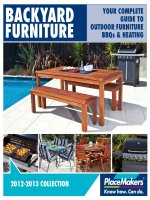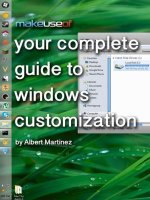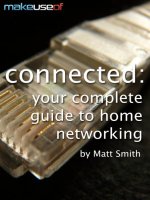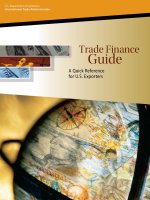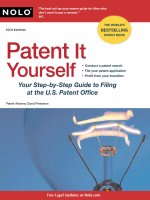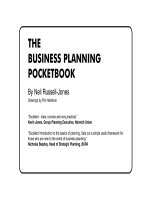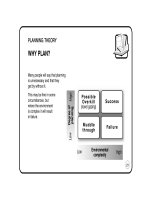patent it yourself, your step-by-step guide to filing at the u.s. patent office 15th (2011)
Bạn đang xem bản rút gọn của tài liệu. Xem và tải ngay bản đầy đủ của tài liệu tại đây (16.04 MB, 628 trang )
Patent Attorney David Pressman
15TH EDITION
“The best roll-up-your-sleeve guide for filers who
don’t want to pay a ransom.”
INC.
Patent It
• Conduct a patent search
• File your patent application
• Profit from your invention
Free Legal Updates at Nolo.com
Yourself
THE WORLD’S
BESTSELLING
PATENT BOOK
N O LO
®
Your Step-by-Step Guide to Filing
at the U.S. Patent Office
e Story
Dear friends,
Founded in 1971, and based in an old clock factory in Berkeley,
California, Nolo has always strived to off er clear legal information
and solutions. Today we are proud to off er a full range of plain-
English law books, legal forms, software and an award-winning
website.
Everything we publish is relentlessly researched and tested by a
dedicated group of in-house legal editors, who together have more
than 150 years’ experience. And when legal changes occur after
publication, we promptly post free updates at Nolo.com.
Tens of millions of Americans have looked to Nolo to help solve
their legal and business problems. We work every day to be
worthy of this trust.
Ralph Warner
Nolo co-founder
Emma Cofod
Books & Software
Get in-depth information. Nolo publishes hundreds of great books and
software programs for consumers and business owners. ey’re all available
in print or as downloads at Nolo.com.
Legal Encyclopedia
Free at Nolo.com. Here are more than 1,400 free articles and answers to
common questions about everyday legal issues including wills, bankruptcy,
small business formation, divorce, patents, employment and much more.
Plain-English Legal Dictionary
Free at Nolo.com. Stumped by jargon? Look it up in America’s most
up-to-date source for defi nitions of legal terms.
Online Legal Documents
Create documents at your computer. Go online to make a will or living
trust, form an LLC or corporation or obtain a trademark or provisional
patent at Nolo.com. For simpler matters, download one of our hundreds
of high-quality legal forms, including bills of sale, promissory notes,
nondisclosure agreements and many more.
Lawyer Directory
Find an attorney at Nolo.com. Nolo’s unique lawyer directory provides
in-depth profi les of lawyers all over America. From fees and experience
to legal philosophy, education and special expertise, you’ll fi nd all the
information you need to pick a lawyer who’s a good fi t.
Free Legal Updates
Keep up to date. Check for free updates at Nolo.com. Under “Products,”
fi nd this book and click “Legal Updates.” You can also sign up for our free
e-newsletters at Nolo.com/newsletters/index.html.
Products
&
Services
“ In Nolo you can trust.”
THE NEW YORK TIMES
“ Nolo is always there in a jam as the nation’s premier publisher
of do-it-yourself legal books.”
NEWSWEEK
“ Nolo publications…guide people simply through the how,
when, where and why of the law.”
THE WASHINGTON POST
“ [Nolo’s]…material is developed by experienced attorneys who
have a knack for making complicated material accessible.”
LIBRARY JOURNAL
“ When it comes to self-help legal stuff , nobody does a better job
than Nolo…”
USA TODAY
“ e most prominent U.S. publisher of self-help legal aids.”
TIME MAGAZINE
“ Nolo is a pioneer in both consumer and business self-help
books and software.”
LOS ANGELES TIMES
e Trusted Name
(but don’t take our word for it)
Patent It
Yourself
Your Step-by-Step Guide to
Filing at the U.S. Patent Office
Patent Attorney David Pressman
15th edition
L A W f o r A L L
FIFTEENTH EDITION APRIL 2011
Editor RICHARD STIM
Cover Design SUSAN PUTNEY
Book Design TERRI HEARSH
Proofreading ROBERT WELLS
Index JULIE SHAWVAN
Printing DELTA PRINTING SOLUTIONS, INC.
ISSN: 1554-9925
ISBN-13: 978-1-4133-1382-6
ISBN-10: 1-4133-1382-5
Copyright © 1985, 1995, 1996, 1997, 1998, 2000, 2002, 2003, 2004, 2005, 2006, 2008, 2009, and 2011
by David Pressman.
All rights reserved. e NOLO trademark is registered in theU.S.Patent and Trademark O ce.
Printed in the U.S.A.
No part of this publication may be reproduced, stored in a retrieval system, or transmitted in any
form or by any means, electronic, mechanical, photocopying, recording, or otherwise without prior
written permission. Reproduction prohibitions do not apply to the forms contained in this product
when reproduced for personal use. For information on bulk purchases or corporate premium sales,
please contact the Special Sales Department. Nolo, 950 Parker Street, Berkeley, California 94710.
Please note
We believe accurate, plain-English legal information should help you solve many of
your own legal problems. But this text is not a substitute for personalized advice
from a knowledgeable lawyer. If you want the help of a trained professional—and
we’ll always point out situations in which we think that’s a good idea—consult an
attorney licensed to practice in your state.
Acknowledgments
My deep thanks go to my clients, and other inventors whose creativity and genius
I so greatly admire and envy. My readers have given me much valuable feedback and
suggestions, and I am grateful to them as well.
I also thank the sta at Nolo, including Richard Stim, Steve Elias, Patti Gima,
Stephanie Harolde, and Ralph Warner for their ideas, contributions, and support, and,
especially, Terri Hearsh for substantially improving the look and feel of the book.
Finally, I thank my wife Roberta for her unagging support and contributions.
Table of Contents
Your Legal Companion
A. You Don’t Have to Use a Patent Attorney 2
B. A Layperson Can Do a Quality Job 2
C. Using an Attorney 2
D. Should You Do It Yourself? 3
E. New Material in the Fifteenth Edition 5
F. How to Use Patent It Yourself 5
1
Introduction to Patents and Other Intellectual Property
A. What Is a Patent and Who Can Apply for It? 9
B. e ree Types of Patents 9
C. e Novelty and Unobviousness Requirement 10
D. How Long Do Patent Rights Last? 13
E. Patent Filing Deadlines 13
F. Patent Fees 13
G. e Scope of the Patent 14
H. How Patent Rights Can Be Lost 14
I. What Rights a Patent Grants and the Prior-Art Reference
Value of a Patent 14
J. What Can’t Be Patented 15
K. Some Common Patent Misconceptions 16
L. How Intellectual Property Law Provides “Offensive Rights”
(and Not Protection) to Inventors 16
M. Alternative and Supplementary Offensive Rights 17
N. Intellectual Property—e Big Picture 17
O. Trademarks 18
P. Copyright 21
Q. Trade Secrets 25
R. Unfair Competition 28
S. Acquisition of Offensive Rights in Intellectual Property—Summary Chart 29
T. Summary of Legal Remedies for Misappropriation of Various
Types of Intellectual Property 29
U. Invention Exploitation Flowchart 31
V. Summary 31
2
e Science and Magic of Inventing
A. What I Mean by “Invention” 34
B. Inventing by Problem Recognition and Solution 35
C. Inventing by Magic (Accident and Flash of Genius) 37
D. Making Ramifications and Improvements of Your Invention 38
E. Solving Creativity Problems 39
F. Contact Other Inventors 41
G. Beware of the Novice Inventor’s “PGL Syndrome” 41
H. Don’t Bury Your Invention 42
I. Summary 42
3
Documentation and the PPA
A. Introduction 45
B. Documentation Is Vital to the Invention Process 45
C. Documentation Is Vital to Prove Inventorship 46
D. Trade Secret Considerations 47
E. Record Conception and the Building and Testing of Your Invention 48
F. How to Record Your Invention 49
G. Another Way to Record Conception or Building and Testing—
e Invention Disclosure 54
H. e Provisional Patent Application—
A Substitute for Building and Testing, With Some Disadvantages 56
I. Don’t Sit on Your Invention After Documenting It 77
J. Don’t Use a “Post Office Patent” to Document Your Invention 77
K. Summary 77
4
Will Your Invention Sell?
A. Why Evaluate Your Invention for Salability? 80
B. Start Small but Ultimately Do It Completely 81
C. You Can’t Be 100% Sure of Any Invention’s Commercial Prospects 81
D. Take Time to Do a Commercial Feasibility Evaluation 81
E. Check Your Marketability Conclusions Using the Techniques of
Consultation and Research 87
F. Now’s the Time to Build and Test It (If Possible) 89
G. e Next Step 90
H. Summary 91
5
Is It Patentable?
A. Patentability Compared to Commercial Viability 95
B. Legal Requirements for a Utility Patent 95
C. Requirement #1: e Statutory Classes 96
D. Requirement #2: Utility 100
E. Requirement #3: Novelty 102
F. Requirement #4: Unobviousness 107
G. e Patentability Flowchart 117
H. Don’t Make Assumptions About the Law 118
I. Summary 118
6
Search and You May Find
A. Why Make a Patentability Search? 121
B. When Not to Search 123
C. e Two Ways to Make a Patentability Search 123
D. e Quality of a Patent Search Can Vary 124
E. How to Hire a Patent Professional 125
F. How to Prepare Your Searcher 127
G. Analyzing the Search Report 127
H. Computer Searching 139
I. Do-It-Yourself Searching 143
J. e Scope of Patent Coverage 154
K. Patent and Trademark Depository Libraries 156
L. Problems Searching Software and Business Inventions 159
M. Searches on the Internet 159
N. MicroPatent Patent Searches on the Internet 166
O. NPL (Non-Patent Literature) Searches 166
P. Summary 167
7
What Should I Do Next?
A. Drop It If You Don’t See Commercial Potential (Chart Route 10-12-14-X) 170
B. Try to Sell Invention to Manufacturer Without “Regular” Patent
Application (Chart Route 10-12-14-16-18-B) 170
C. File an Application and Sell It to or License a Manufacturer
If You See Commercial Potential and Patentability
(Chart Route 14-16-18-20-22-A) 172
D. If You Have Commercial Potential Without Patentability,
License or Sell Your Invention to a Manufacturer Without Filing
(Chart Route 16-24-26-28-30-B) 173
E. Make and Sell Your Invention Yourself Without a Utility
Patent Application (Chart Route 16-30-C) 175
F. Manufacture and Distribute Your Invention Yourself,
Keeping It as a Trade Secret (Chart Route 20-32-34-D) 175
G. File Patent Application and Manufacture and Distribute Your Invention
Yourself (Trade-Secretable Invention) (Chart Route 20-32-34-36-E) 176
H. File Patent Application and Manufacture and Distribute Invention
Yourself (Non-Trade-Secretable Invention) (Chart Route 20-32-38-36-E) 176
I. Test Market Before Filing (Chart Route 20-32-38-40-F) 177
J. Summary 178
8
How to Draft the Specification and Initial Drawings
A. Lay Inventors Can Do It! 181
B. What’s Contained in a Patent Application 181
C. What Happens When Your Application Is Received by the PTO 183
D. Do Preliminary Work Before Preparing Your Patent Application 183
E. Flowchart 185
F. Write Your Patent Specification to Comply With the Full Disclosure Rules 185
G. Software, Computer-Related Inventions, and Business Methods 188
H. First Prepare Sketches and Name Parts 189
I. Drafting the Specification 193
J. Review Your Specification and Abstract Carefully 205
K. Checklist for Your Patent Application Draft 206
L. Specification of Sample Patent Application 206
M. Summary 206
9
Now for the Legalese—e Claims
A. What Are Claims? 225
B. e Law Regarding Claims 226
C. Some Sample Claims 227
D. Common Misconceptions Regarding Claims 231
E. One Claim Should Be as Broad as Possible 232
F. e Effect of Prior Art on Your Claim 233
G. Technical Requirements of Claims 234
H. Drafting Your Main (Independent) Claim 240
I. Other Techniques in Claim Writing 242
J. Drafting Dependent Claims 245
K. Drafting Additional Sets of Claims 249
L. Checklist for Drafting Claims 250
M. Summary 250
10
Finaling and Mailing Your Application
A. e Drawing Choices 256
B. PTO Rules for Drawings 257
C. Doing Your Own Drawings 259
D. Consider Using a Professional Patent Draftsperson 269
E. Finaling Your Specification—For Paper Filing 269
F. Finaling Your Specification for EFS-WebFiling 284
G. File the Information Disclosure Statement Within ree Months 287
H. Assignments 293
I. Petitions to Make Special 293
J. Filing a Design Patent Application 297
K. Summary 300
11
How to Market Your Invention
A. Perseverance and Patience Are Essential 305
B. Overview of Alternative Ways to Profit From Your Invention 306
C. Be Ready to Demonstrate a Working Model of
Your Invention to Potential Customers 308
D. Finding Prospective Manufacturers/Distributors 309
E. e “NIH” Syndrome 310
F. e Waiver and Precautions in Signing It 311
G. e Best Way to Present Your Invention to a Manufacturer 312
H. Presenting Your Invention by Correspondence 313
I. Making an Agreement to Sell Your Invention 314
J. Manufacturing and/or Distributing the Invention Yourself 314
K. Summary 317
12
Going Abroad
A. Introduction 320
B. e Paris Convention and the One-Year Foreign Filing Rule 321
C. Other Priority Treaties Similar to the Paris Convention 321
D. European Patent Office/Europäisches Patentamt/Office
Européen des Brevets (EPO) 321
E. e Patent Cooperation Treaty (PCT) 322
F. Non-Convention Countries 322
G. Never Wait Until the End of Any Filing Period 325
H. e Early Foreign Filing License or Mandatory Six-Month Delay 325
I. Don’t File Abroad Unless Your Invention Has Very Good
Prospects in Another Country 325
J. e Patent Laws of Other Countries Are Different 326
K. e Ways to File Abroad 326
L. Rescind Any Nonpublication Request 332
M. Resources to Assist in Foreign Filing 332
N. Summary 333
13
Getting the PTO to Deliver
A. What Happens After Your Patent Application Is Filed 338
B. General Considerations During Patent Prosecution 341
C. A Sample Office Action 351
D. What to Do When You Receive an Office Action 357
E. Format for Amending the Specification and Claims 365
F. Drafting the Remarks 379
G. Drawing Amendments 385
H. Typing and Filing the Amendment 386
I. If Your Application Is Allowable 389
J. If Your First Amendment Doesn’t Result in Allowance 390
K. Interferences 394
L. Statutory Invention Registration (SIR) 395
M. If Your Application Claims More an One Invention 395
N. e Public May Cite Additional Prior Art Against Your
Published Patent Application 396
O. NASA Declarations 396
P. Design Patent Application Prosecution 396
Q. What to Do If You Miss or Want to Extend a PTO Deadline 397
R. Summary 398
14
Your Application Can Have Children
A. Available Supplemental Cases 400
B. Continuation Applications 402
C. Request for Continued Examination (RCE) 404
D. Divisional Applications 405
E. Continuation-in-Part and Independent Applications 406
F. Reissue Applications 408
G. Statutory Invention Registration (SIR) and Defensive Publications 408
H. Substitute Applications 409
I. Double Patenting and Terminal Disclaimers 409
J. Summary 410
15
After Your Patent Issues:
Use, Maintenance, and Infringement
A. Issue Notification 413
B. Press Release 413
C. Check Your Patent for Errors 413
D. Patent Number Marking 414
E. Advertising Your Patent for Sale 415
F. What Rights Does Your Patent Give You? 415
G. Be Wary of Offers to Provide Information About Your Patent 417
H. Maintenance Fees 418
I. Legal Options If You Discover an Infringement of Your Patent 420
J. What to Do About Patent Infringement 421
K. Product Clearance (Can I Legally Copy or Make at?) 426
L. Citing Prior Art Against Patent Applications and Patents 429
M. e Court of Appeals for the Federal Circuit (CAFC) 430
N. Using the Reexamination Process to Reduce the Expense
of Patent Infringement Suits 431
O. Jury Trials 431
P. Arbitration 432
Q. How Patent Rights Can Be Forfeited 432
R. Your Patent Is Subject to Interference for One Year 433
S. Tax Deductions and Income 433
T. Patent Litigation Financing 433
U. Summary 434
16
Ownership, Assignment, and Licensing of Inventions
A. e Property Nature of Patents 436
B. Who Can Apply for a Patent? 436
C. Joint Owners’ Agreement 437
D. Special Issues Faced by the Employed Inventor 438
E. Assignment of Invention and Patent Rights 440
F. Record Your Assignment With the PTO 441
G. Licensing of Inventions—An Overview 443
H. Universal License Agreement 444
I. How Much Should You Get for Your Invention? 447
J. Summary 449
K. Desiderata for PTO 449
Appendixes
1
Abbreviations Used in Patent It Yourself
2
Resources: Government Publications, Patent
Websites, and Books of Use and Interest
A. Government Publications 454
B. Patent Websites 454
C. Books of Use and Interest 456
D. Books Relating to Self-Improvement 458
3
Glossaries
A. Glossary of Useful Technical Terms 460
B. Glossary of Legal Terms 466
4
Fee Schedule
5
Mail, Telephone, Fax, and Email Communications With the PTO
A. Patent and Trademark Office Mail Addresses 482
B. Patent and Trademark Office Telephones and Faxes 483
6
Quick-Reference Timing Chart
7
Tear-Out Forms
Nondisclosure Agreement
Invention Disclosure
Provisional Patent Application Cover Letter
Application Data Sheet—PTO SB/14
Positive and Negative Factors Evaluation
Positive and Negative Factors Summary
Consultant’s Work Agreement
Searcher’s Worksheet
Drawing Reference Numerals Worksheet
Declaration for Utility or Design Patent Application
Patent Application Declaration (Supplemental Sheet)
Utility Patent Application Transmittal
Fee Transmittal
Credit Card Payment Form
Information Disclosure Statement Cover Letter
Information Disclosure Statement by Applicant
Nonpublication Request
Request Under MPEP 707.07(j)
Petition to Make Special
Design Patent Application
Design Patent Application Transmittal
Request for Expedited Examination of a Design Application
Amendment
Submission of Corrected Drawings
Supplemental Declaration
Petition for Extension of Time
Pre-Appeal Brief Request for Review
Request for Continued Examination (RCE) Transmittal
Request for Certificate of Correction
Certificate of Correction
Maintenance Fee Reminder Sheet
Submission of Maintenance Fee
Joint Applicants—Statement of Respective Contributions
Joint Owners’ Agreement
Assignment of Invention and Patent Application
Recordation Form Cover Sheet
Universal License Agreement
8
Forms Available at the PTO Website
Index
A. You Don’t Have to Use a Patent Attorney 2
B. A Layperson Can Do a Quality Job 2
C. Using an Attorney 2
D. Should You Do It Yourself? 3
E. New Material in the Fifteenth Edition 5
F. How to Use Patent It Yourself 5
Your Legal Companion
2
|
PATENT IT YOURSELF
Patent It Yourself is a guidebook that allows you, the
inventor, to patent and commercially exploit your invention
by yourself. It provides:
• instructions for inventing and documenting an
invention, and how and when to le a Provisional
Patent Application
• step-by-step guidance for obtaining a U.S. patent,
together with tear-out, copyable, or downloadable
forms that are necessary for each step of the process
• an overview of the procedures and requirements
for getting patent protection abroad and concrete
suggestions for nding the necessary resources to help
you do this
• an overview of the alternative and supplementary
forms of protection available for inventions, such
as trade secrets, copyrights, trademarks, and unfair
competition law, and
• detailed information and advice on how to
commercially evaluate, market, and license your
invention.
One purpose of this book is to save you money.
According to the American Intellectual Property
Association, the average cost of preparing a minimally
complex patent application is approximately $8,500;
preparing a relatively complex application—for example, an
application for a chemical, biotech, mechanics, electronics,
or data processing invention—costs between $11,500 and
$15,500. You may not be able to aord these fees, and even
if you can, it still pays to do it yourself. By following the
instructions set out in this book, you’ll not only save on
attorney fees, but you’ll be personally involved in every step
of the patenting process. Aer all, you know your invention
better than anyone else, and assuming you’re willing
and able to wade through a number of patent rules and
technicalities, you’re the best person to patent it.
I think of the book as a great equalizer, since it provides
the know-how to enable the garage-shop or basement do-
it-yourselfer to get as good a patent as a large corporation.
It provides the legal tools necessary for inventors (whether
large or small) to provide rst-class legal protection for
their work. And it especially gives the small inventor the
tools to competently and eciently protect an invention,
whether or not he or she can aord a patent attorney.
A. You Don’t Have to Use a Patent Attorney
In this view, many inventors believe that one must use a
patent attorney to get a valid patent. is isn’t true. First,
the laws contain absolutely no requirement that one must
have a patent attorney to le a patent application, deal
with the PTO concerning the application, or to obtain
the patent. In fact, PTO regulations (Manual of Patent
Examining Procedure (MPEP), Section 707.07(j)) specically
require patent examiners to help inventors in pro se (no
lawyer) cases. Second, and perhaps more persuasive, many
hundreds of patent applications are led and successfully
prosecuted each year by pro se inventors.
B. A Layperson Can Do a Quality Job
e quality of a patent is mainly dependent upon four basic
factors:
1. whether the patent application contains a full, clear,
and accurate description that tells how to make and
use the invention
2. whether the reach of the patent (technically covered
in the patent “claims”) is as broad as possible, given
the state of prior developments in the eld
3. whether the application “sells” the advantages of the
invention, and
4. how an applicant handles correspondence with the
PTO.
Fortunately, it takes no special legal expertise to do an
excellent job for these, especially if you utilize the many
checklists we have provided throughout this book.
C. Using an Attorney
Even if you do choose to work with an attorney, or have
one available to you through the process, you’ll nd that
this book allows you to take an active role in the process,
do a better job of monitoring your attorney (no trivial
consideration), and greatly adds to your understanding
of the ways in which the law is willing to protect your
invention. No matter how competent an attorney is, the
client who understands what’s going on will always obtain
better service. Indeed, many corporate legal departments
use this book to educate their inventors and support
personnel to deal with patent attorneys and to protect their
inventions more eectively.
I have seen a number of inventors who were victimized
by their attorney (or agent) by allowing the attorney to le
an application or continue prosecution at great expense
even though the invention had a serious commercial
drawback or was mostly anticipated by prior art. Had they
considered the comments in this book, taken more interest,
and followed what the attorney and/or the PTO was doing,
they would have known that it would have been unwise to
continue. By terminating at an earlier stage, they could have
saved hundreds, or even thousands of dollars.
YOUR LEGAL COMPANION|3
D. Should You Do It Yourself?
e big question is, of course, even though many if not most
inventors can le and handle their own patent application,
should you do so on your own or hire an expert? Aer
all, you probably hire people to do all sorts of things for
you, from xing your car to remodeling your kitchen, that
you could do yourself. e most powerful incentive for
patenting it yourself is the amount of money expert help
costs. Or put another way, even though most car mechanics
make a pretty good living, most of them can’t aord
to belong to the same country club as patent attorneys.
e cost factor alone may dictate your decision for you
if you can’t aord the $5,000 to $15,000 most attorneys
now charge to prepare a patent application on a simple
invention.
On the other hand, if you’re fortunate enough to be able
to aord an attorney and you either don’t have enough time
to do it yourself, you don’t think you’ll be able to write a
detailed description of your invention in conjunction with
drawings (it’s easier than you think), you aren’t diligent and
committed enough to complete projects in a reasonable
time, or you think you can’t complete a detailed writing job
in a fairly high-quality manner, then perhaps you should
use an attorney in conjunction with Patent It Yourself, to
monitor and enhance the attorney’s work.
e above can be expressed by the following proportion:
DIY α
AT•WA•D•DC
AF
which means you should be inclined to Do It Yourself in
direct proportion to your Available Time, your Writing
Ability, your Diligence, and your Desire to Control things,
and in inverse proportion to your Available Funds. While
this proportion isn’t even an approach at precision, it
provides the appropriate criteria and how to use them when
making the do-it-yourself versus hire-an-attorney decision.
e best answer for some inventors may be to do some of
both. Using this approach, diligent inventors will do much
of the patent work themselves, only consulting with an
attorney at an hourly rate if snags develop, or to check the
patent application before submission.
Proposed Legislation at May Affect Your Patent
As this edition goes to press, important changes have been
proposed in the patent rules and laws. If implemented, these
changes will likely reduce the strength of patents. Some
powerful entities, mainly computer,software, and financial
servicecompanies, are in favor of these changes. Other
powerful entities, mainly drug companies, independent
inventors, Nobel laureates, and some legislators, want to keep
patents strong and thus are opposed to these changes. e
winner will be determined to a large extent by the influence
of each side over our legislators. Here is a status report as of
this edition (February 2011).
New Rule Changes Halted: e PTO issued new rules
regarding (a) the number of applications that may be
permitted in a chain of continuing applications, and (b)
the number of claims that may be filed. A number of
organizations have sued the PTO, contending that these
changes go beyond the PTO’s powers. A trial court tentatively
agreed and has issued a temporary injunction, ordering
the PTO not to implement the new rules until the issues
are resolved after a full trial. However, the appellate court
reversed part of the trial court’s decision, holding that the
PTO may limit the number of applications in a chain. Check
my blogsite at
for further updates.
New Patent Revision Bills Stalled: Various patent revision
bills are pending: One bill that would completely revise the
patent statutes is pending, but has been derailed because of
protests by inventors, concerned legislators, drug and biotech
companies, labor unions, manufacturing and chemical
companies, research universities, and a new administration.
Complete inform ation about the bill and the arguments
against its provisions can be found on the Professional
Inventors’ Alliance site, (www.piausa.org).
While this revision has some provisions that would help
independent inventors, I believe that its overall effect would
be harmful. I urge you to call and write to your federal
representatives and senators to urge them to oppose this
bill in order to keep our patent system strong, since I believe
that this is one of the main factors that has made the U.S. a
technological leader. Another bill would change the patent
system into a three-tiered system where every patent
applicant could elect to either (a) have the patent application
examined right away for a relatively large fee, (b) have it
examined in the normal course for a moderate fee, or (c) have
examination deferred for a number of years and not pay any
examination fee until examination was requested.
I will post the resolution of these issues on the update site
for Patent It Yourself at Nolo’s site (www.nolo.com).
—David Pressman
4
|
PATENT IT YOURSELF
Patent It Yourself—Quick-Start Guide
We realize that Patent It Yourself is a big book, and we hope
you will read it from cover to cover to get a full picture of the
field of patents and inventions. However if you don’t have
the time, this Quick-Start Guide will tell you where to look to
accomplish a specific task.
Task What to Read or Do
You’ve invented something and you want to
protect it.
Follow the RESAM procedure (Chapter 1):
Record the invention properly or file a Provisional Patent Application
(Chapter 3).
Evaluate commercial potential to see if it will sell (Chapter 4).
Search it for patentability to see if you will be able to get a patent
(Chapters 5 and 6).
Apply for a patent (Chapters 8 through 10).
Market it to a suitable company (Chapter 11).
You have a patent and want to license or sell it. Read Chapter 11 on Marketing.
You have a patent that may be infringed. Read Chapter 15 to learn how to determine whether it’s infringed and how
to go after the infringer.
You have a patent and want to maintain it. Read Chapter 15 on Maintenance Fees.
You have a patent and want to sell or license it. Reach Chapter 16 on Assignments and Licensing.
You want to learn about all forms of intellectual
property.
Read Chapters 1 and 7.
You want to determine whether your invention
will sell.
Read Chapter 4 on Evaluating Commerciality.
You want to see if your invention is patentable. Read Chapters 5 and 6 on Patentability and Searching.
You want to get a monopoly on your invention
abroad.
Read Chapter 12 on Foreign Patenting.
You have a pending patent application and want
to learn how to deal with the Patent Office.
Read Chapter 13 on Patent Application Prosecution and Chapter 14 on
Branches of Your Application.
You want to see more reference sources for
inventors.
Read Appendix 2, Resources.
You need a name for something or a definition of
a patent-legal term.
See Appendix 3, Glossaries.
You want to determine a Patent Office fee. See Appendix 4, Fee Schedule.
You need to contact the PTO. See Appendix 5, PTO telephones, etc.
You need to determine a time limit. See Appendix 6, Timing Chart.
You need a patent form. See Appendix 7, Forms.
YOUR LEGAL COMPANION|5
E. New Material in the Fifteenth Edition
In the eenth edition, you’ll nd information about:
• new standards for process or method claims as
established in the Supreme Court’s Bilski v. Kappos
(2010)
• searching techniques for the PTO’s EAST/PubWEST
Search systems
• updated Google Patent Search information
• new eFiling procedures at the PTO
• venture capital funding
• changing legal trends that disfavor independent
inventors
• public citation of prior art
• revised continuation rules
• patent trolls and submarine patents
• new design patent infringement standards as
established in the Egyptian Goddess, Inc. v. Swisa, Inc.
case.
F. How to Use Patent It Yourself
e book is organized primarily for chronological use,
starting with an overview of the entire intellectual property
eld (which includes patents, trademarks, copyright, and
trade secret law). en it sequentially covers the steps most
inventors will take to monopolize and prot from their
inventions. I strongly recommend that you rst read the
book all the way through, skimming lightly over the many
chapters that actually tell you how to do things.
In this way you’ll rst get an overview of the patent forest
before you return and deal with the individual steps (trees)
necessary to fully protect your invention.
roughout the book I refer to a number of forms and
in many instances reproduce them in the text. A tear-out
or copyable version of each is also located in Appendix7
for your use, and all PTO forms can be downloaded from
the PTO website. If you don’t have Internet access, I recom-
mend that you make photocopies of PTO forms so you’ll have
ample spares for dras and extra copies for your records.
Also throughout the book I refer to various statutes
and governmental administrative rules, mostly in the
patent area. I use standard forms of legal citation; these are
interpreted as follows:
• 35 USC 102 = Title 35 of the U.S. Code, Section 102
• 37 CFR 1.111 = Title 37 of the (U.S.) Code of Federal
Regulations, Section 1.111.
Title 35 of the U.S. Code (USC) contains all of the
federal patent statutes and Title 37 of the U.S. Code of
Federal Regulations (CFR) contains all of the federal
administrative rules issued by the Patent and Trademark
Oce and Copyright Oce that deal with patents, trademarks,
and copyright matters. Part 1 of 37 CFR is concerned with
patents. us Patent Rule 111 = 37 CFR 1.111.
In addition to the Patent Rules, the PTO publishes much
more information on the patent process in its Manual of
Patent Examining Procedure (MPEP), which is available
online. Both the U.S. Code and the CFR are available in any
law library and online as part of the MPEP, as indicated in
Appendixes 2 and 5, Resources: Government Publications,
Patent Websites, and Books of Use and Interest; and Mail,
Telephone, Fax, and Email Communications With the PTO.
I’ve used many abbreviations throughout Patent It Yourself
to save space and spare you the tedium of repeatedly reading
long phrases. I’ve tried to dene each abbreviation the rst
time I’ve used it and again if there is a long break before it is
used again. If at any time you need to refresh your memory
about a particular abbreviation, please refer to Appendix 1,
Abbreviations Used in Patent It Yourself.
Appendix 3 provides two dictionaries. e rst is a list of
technical terms used in the preparation of patent applications
(Glossary of Useful Technical Terms). e second list
provides denitions for many of the terms used throughout
this book (Glossary of Legal Terms).
e law is constantly changing. We try to update the
important changes in each printing, but in the meantime
you can get updates at www.patentityourself.com and www.
nolo.com.
Welcome to the world of intellectual property! Good luck
and successful inventing!
l
A. What Is a Patent and Who Can Apply for It? 9
B. e ree Types of Patents 9
C. e Novelty and Unobviousness Requirement 10
D. How Long Do Patent Rights Last? 13
E. Patent Filing Deadlines 13
F. Patent Fees 13
G. e Scope of the Patent 14
H. How Patent Rights Can Be Lost 14
I. What Rights a Patent Grants and the Prior-Art Reference Value of a Patent 14
J. What Can’t Be Patented 15
K. Some Common Patent Misconceptions 16
L. How Intellectual Property Law Provides “Offensive Rights”
(and Not Protection) to Inventors 16
M. Alternative and Supplementary Offensive Rights 17
N. Intellectual Property—e Big Picture 17
O. Trademarks 18
1. Trademarks Defined 18
2. Monopoly Rights of a Trademark Owner 19
3. Relationship of Trademark Law to Patent Law 19
4. Overview of How Offensive Rights to Trademarks Are Acquired 19
5. What Doesn’t Qualify as a Trademark (for the Purpose of
Developing Offensive Rights) 21
P. Copyright 21
1. What Is Copyright? 22
2. Copyright Compared With Utility Patent 22
3. Areas Where Patent and Copyright Law Overlap 23
4. When and How to Obtain Copyright Coverage 24
Q. Trade Secrets 25
1. Definition 25
2. Relationship of Patents to Trade Secrets 26
C H A P T E R
1
Introduction to Patents and
Other Intellectual Property
